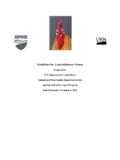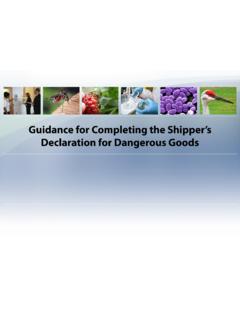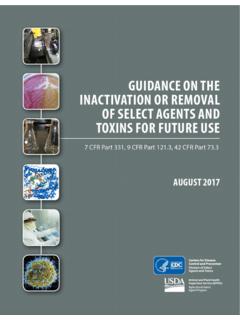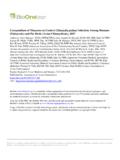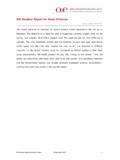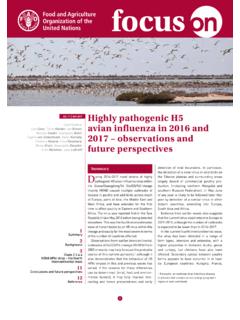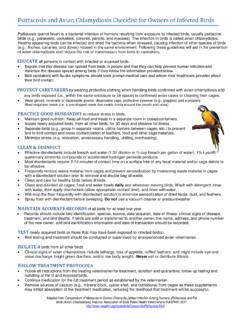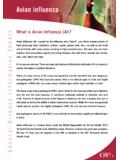Transcription of Guidelines for Avian Influenza Viruses - Select Agents
1 Guidelines for Avian Influenza Viruses Prepared by Department of Agriculture Animal and Plant Health Inspection Service Agriculture Select Agent Services Date Prepared: November 4, 2011 (Updated February 28, 2018)1 Table of Contents Page Purpose .. 2 Introduction .. 2 Categorizing Influenza A and Nomenclature .. 3 Defining Highly Pathogenic Avian Influenza Virus .. 4 Understanding Influenza A Reassortant 4 Regulating .. 5 Avian Influenza Virus .. 5 Experimental Reassortant Influenza Viruses .. 6 Nucleic Acids .. 8 Introduction to Biocontainment Provisions .. 8 Biosafety Level 4 and Animal Biosafety Level 4.
2 9 Biosafety Level 3 Agriculture .. 9 Biosafety Level 3 .. 9 Animal Biosafety Level 3 .. 10 Biosafety Level 2 and Animal Biosafety Level 2 .. 12 Transfer and Permitting of Highly Pathogenic Avian Influenza Viruses and Low Pathogenic Avian Influenza Viruses .. 13 Summary .. 13 References .. 15 Contact Information .. 17 2 Purpose The Agricultural Select Agent Services (AgSAS) prepared this document to assist individuals and entities develop policies and implement procedures for working safely with Avian Influenza Viruses (AIV) in the laboratory. The Guidelines provide a basic understanding of AIV as well as guidance to meet the requirements of Title 9, Code of Federal Regulations (CFR), Parts 121 (Possession, Use, and Transfer of Select Agents and Toxins) and 122 (Importation and Transportation of Controlled Organisms and Vectors).
3 Introduction AIV is one the most significant Viruses of concern to the poultry industry in the United States and around the world. The main focus of the Department of Agriculture (USDA) is the domestic poultry population comprised of chickens and turkeys; they make up the largest percentage of the commercial poultry industry. However, under the broader definition, domestic poultry also includes ducks, quail, pheasants, and pigeons. Avian Influenza (AI) is an infectious disease of birds caused by type A strains of the Influenza virus. Type B and C Influenza Viruses are not known to infect poultry or do not cause disease in poultry.
4 AI is a highly contagious disease and some strains can cause high mortality in poultry. Influenza A virus in the natural environment is generally spread by ingestion or inhalation. The virus is found in high concentrations in saliva, nasal secretions, and feces. AIV can remain viable for long periods in tissues, feces, and water, especially at low temperatures. Virus-laden feces and respiratory secretions present on fomites such as equipment, clothing, flies, and contaminated feed and water are effective means of transmitting the virus. AIV is also transmitted by airborne dissemination. However, AIV is among the easiest Viruses to inactivate using disinfectants or heat treatment.
5 The highly pathogenic form of the disease is systemic and may be characterized clinically by severe depression, ocular and nasal discharges, snicking (a hacking sound made to clear the throat), decrease in egg production, nervous system changes, edema of the head, tissue necrosis, sudden death, and high mortality. Morbidity and mortality associated with outbreaks of this highly pathogenic form may reach 90 100 percent within 1 2 weeks in susceptible poultry. Illness associated with the low pathogenic form of the disease is usually mild unless complicated by concurrent bacterial or viral infections, and environmental stressors.
6 Depending on the size of an outbreak, the measures taken to control and eradicate the virus, and the speed to implement control and eradication strategies, trading partners may implement regional or country-wide restrictions, resulting in significant economic losses in the poultry industry and increased costs to consumers. The magnitude and duration of these events will ultimately determine the overall impact to the economy. Outbreaks in the United States have occurred in 1924, 1983, 2004, and 2015. The 2015 United States outbreak incurred an estimated cost of $ billion in lost birds and $ billion in economy-wide losses.
7 In addition, the USDA committed $500 million to address emergency efforts to block the disease and paid out $190 million for indemnity payments (8). 3 Categorizing Influenza A and Nomenclature Influenza A Viruses are divided into subtypes and are identified on the basis of two surface glycoproteins or antigens: hemagglutinin (HA or H) and neuraminidase (NA or N). There are eighteen known HA subtypes (H1 to H18) and eleven known NA subtypes (N1 to N11); each virus has one HA and one NA protein on the surface. For example, an H5N1 virus designates an Influenza A subtype that has an HA 5 surface protein and an NA 1 surface protein.
8 The nomenclature of AIVs is based on a standardized format: Type/species/location/virus identification/year of isolation (HxNx), representing the Influenza type, the host origin, the place of isolation, the strain number, and the Influenza A subtype. For example, A/Ck/TX/309402/04 (H5N2) represents an H5N2 Influenza A virus that was isolated from a chicken in Texas in 2004 and assigned strain number 309402. AIV strains are further classified as low or highly pathogenic on the basis of specific molecular determinants of the HA protein and the biological behavior of the virus using in-vitro and in-vivo tests. Most AIVs are associated with mild disease in poultry and are termed low pathogenic Avian Influenza Viruses (LPAIVs).
9 By contrast, AIVs that are associated with severe illness and high mortality in poultry are termed highly pathogenic Avian Influenza Viruses (HPAIVs). To date, all outbreaks of the highly pathogenic form of the disease have been caused by Influenza A Viruses of the subtypes H5 or H7. However, it is important to emphasize that the majority of H5 and H7 subtypes isolated from birds have been LPAIVs. All known Influenza A Viruses circulate in their natural bird hosts, wild aquatic birds ( , ducks, geese, and swans) and shorebirds ( , gulls and terns), except subtypes H17N10 and H18N11 which have only been found in bats.
10 Traditionally, HPAIVs have not been observed in reservoir hosts. However, there is evidence to suggest that some migratory waterfowl can now carry the H5N1 virus in its highly pathogenic form in many parts of the world (11, 12). It remains unclear whether wild migrating birds are an established reservoir for H5N1 in its highly pathogenic form. Based on previous investigations of HPAI outbreaks, it is generally recognized that most HPAIVs evolve after transmission of LPAIV H5 and H7 subtypes from a wild reservoir host to a poultry host. The virus adapts to poultry hosts and mutates to a HPAIV through multiple replication cycles and/or bird transmissions.
